Generations : interpreting Iron Age ceramics
digital ceramics, 2025 - ongoing
This project is a work-in-progress with ceramicist Anna Andersen. Building on our experiments in A pot, we continue exploring generative AI as a creative tool in ceramic practice, this time in dialogue with Iron Age vessels from the collection at Horsens Museum, in Jylland, DK. These ancient pots have been excavated from different sites across Horsens Kommune; from the well-known burial site at Hedegård to unexpected finds unearthed during the recent construction work along the E45 highway. Working with these archaeological fragments, we explore how our hybrid process of digital generation, machine work, and hand work might create a conversation between present and past ways of making.
We use generative AI in two ways: “reconstructing” 3D digital interpretations of the artifacts from photographs, and using text prompts to describe Iron Age forms to 3D-model-generating tools. These AI outputs become digital sketches that are the starting points in our design process. We combine machine and human expression by building our designs using a combination of clay 3D printing and hand sculpting. With this work, we test whether contemporary technology can help us engage more deeply with histories of making, creating vessels that honor both the tactile expressions of Iron Age potters and our own digital-physical ceramics practice.
We use generative AI in two ways: “reconstructing” 3D digital interpretations of the artifacts from photographs, and using text prompts to describe Iron Age forms to 3D-model-generating tools. These AI outputs become digital sketches that are the starting points in our design process. We combine machine and human expression by building our designs using a combination of clay 3D printing and hand sculpting. With this work, we test whether contemporary technology can help us engage more deeply with histories of making, creating vessels that honor both the tactile expressions of Iron Age potters and our own digital-physical ceramics practice.
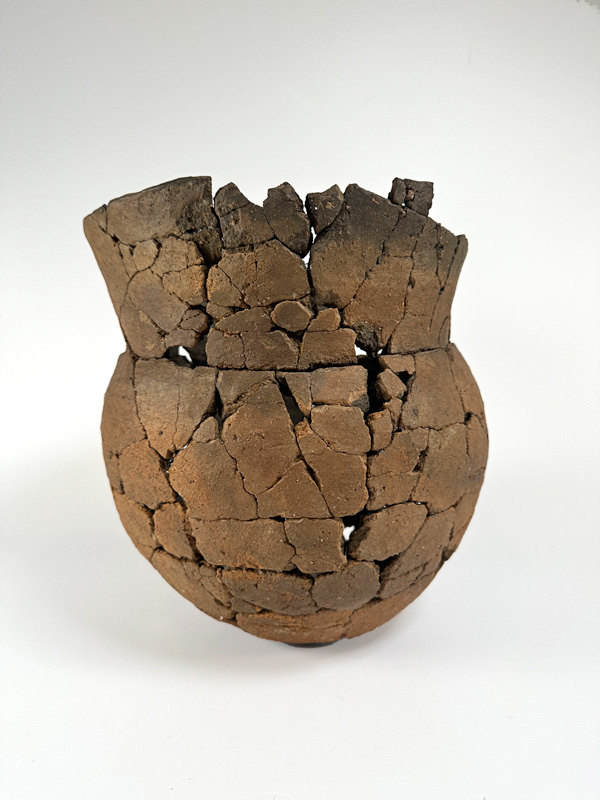
Iron Age pot ca. 100 BC, excavated in Horsens, DK.
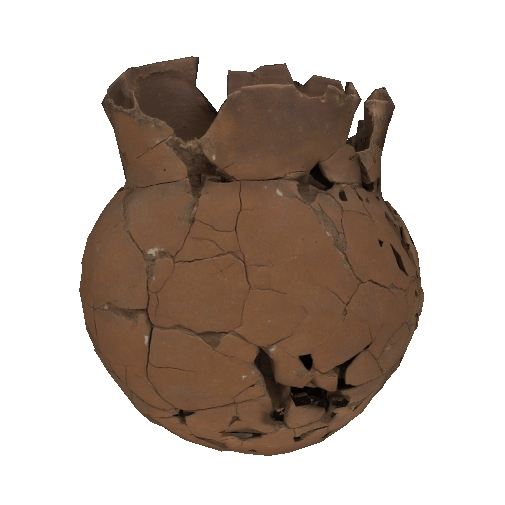
AI-generated 3D model of an Iron Age pot.

Fracture pot, 3D-printed and hand-sculpted mixed clay (greenware).
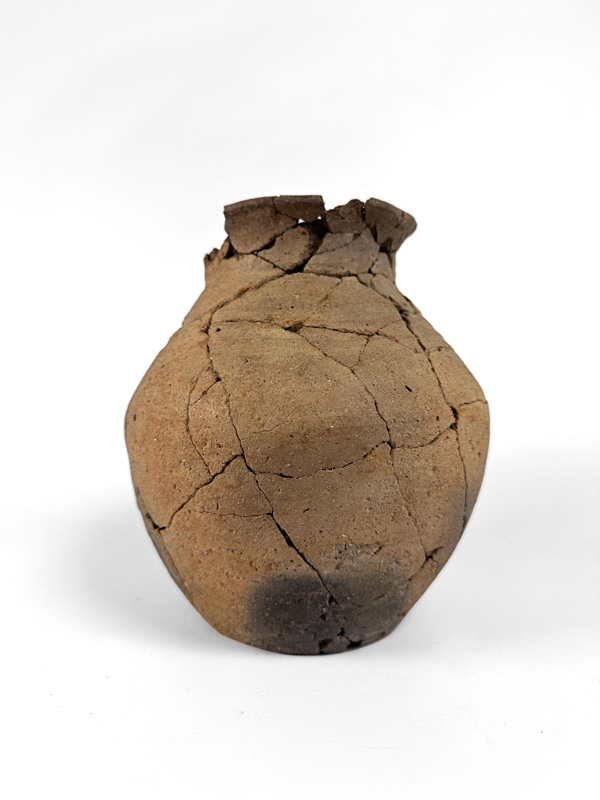
Iron Age pot ca. 100 BC, excavated from Hedegård, Horsens, DK.
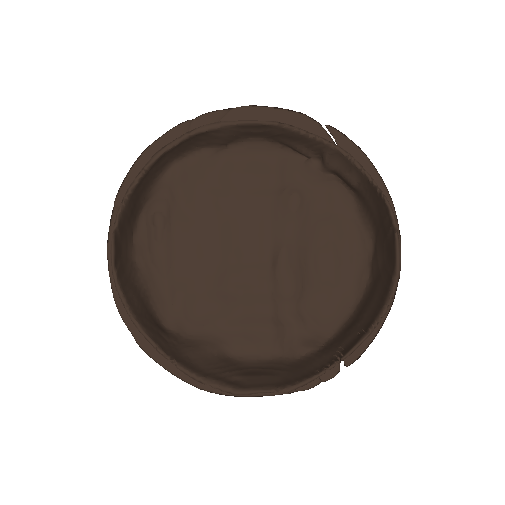
AI-generated 3D model of a “Danish Iron Age pot excavated in Horsens, Denmark.”
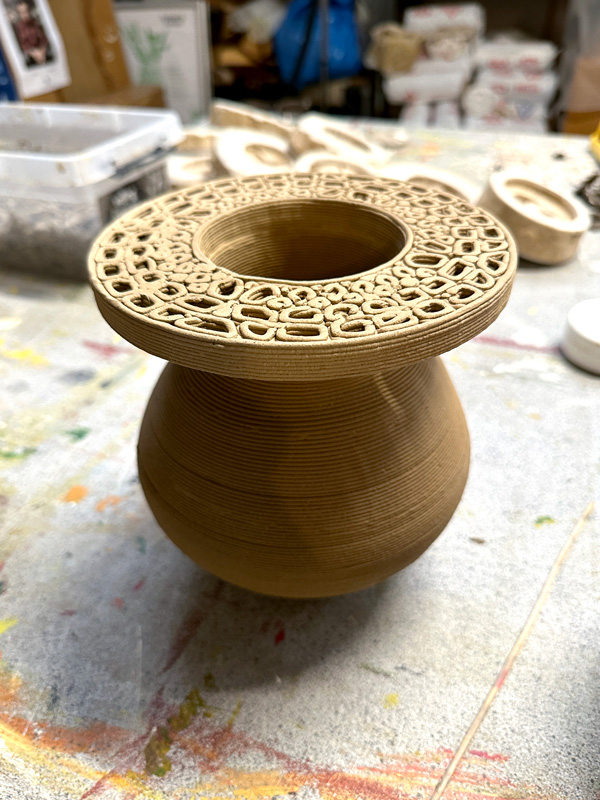
Pebble jar, 3D-printed and hand-sculpted mixed clay 20 x 20 x 22 cm (greenware).
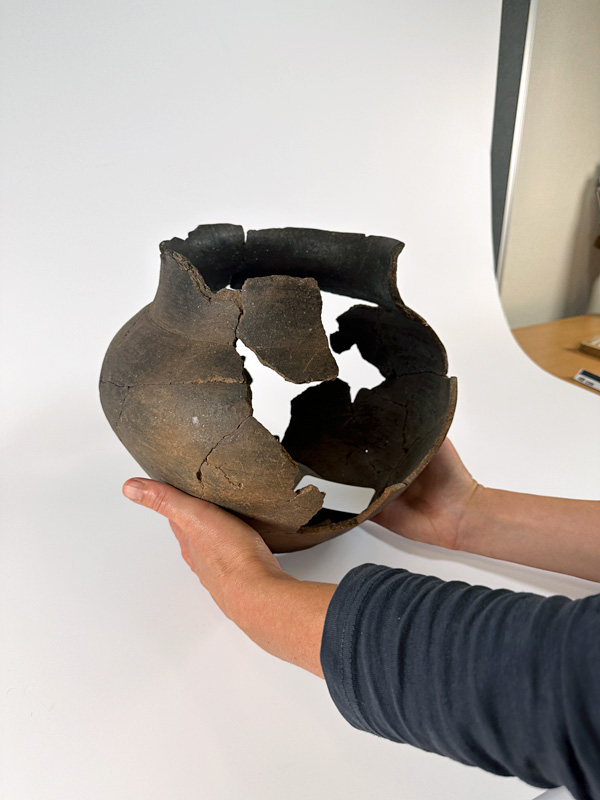
Iron Age pot ca. 100 BC, excavated in Horsens, DK.
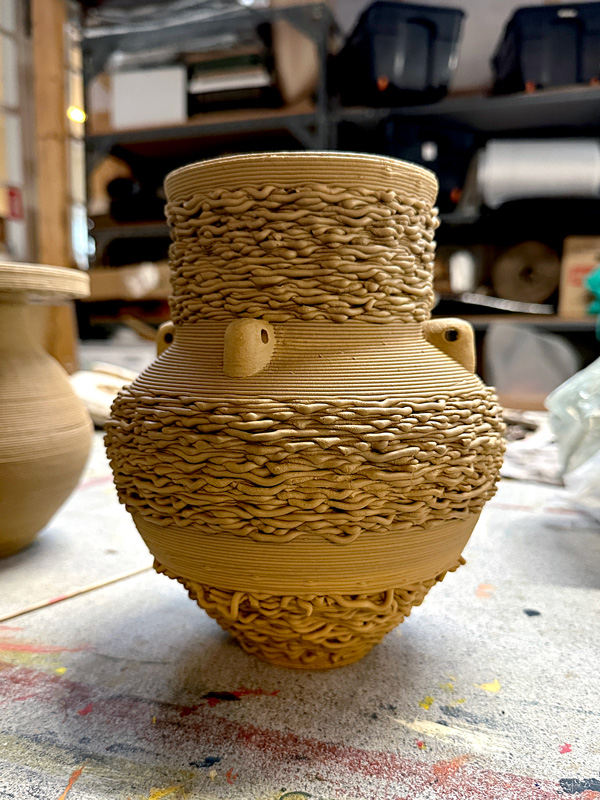
Looping pot, 3D-printed and hand-sculpted mixed clay, 20 x 19 x 25 cm (greenware).
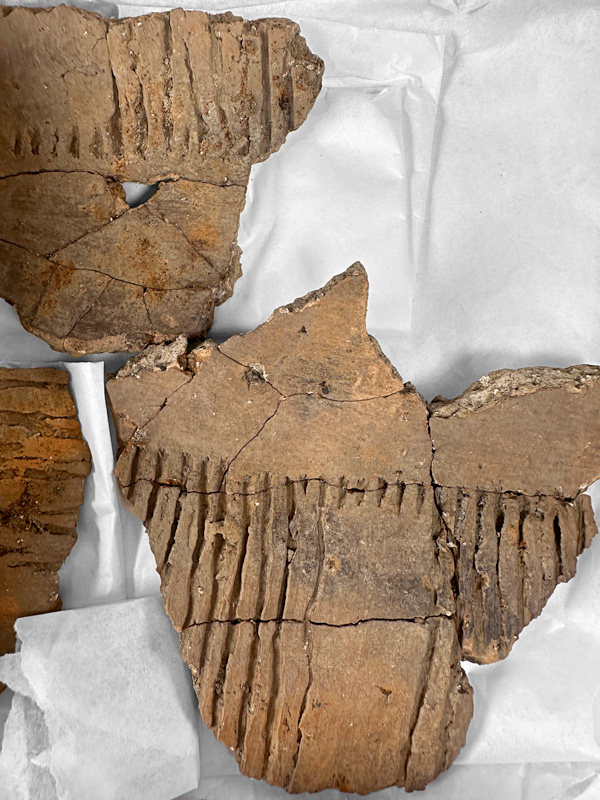
Iron Age pot fragments ca. 100 BC, with incised surface decoration.

Iron Age jar fragment ca. 100 BC, excavated in Horsens, DK.

AI-generated 3D model of an Iron Age jar fragment.
 Jar prototype being 3D printed in mixed earthenware clay, 20 x 18 x 38 cm.
Jar prototype being 3D printed in mixed earthenware clay, 20 x 18 x 38 cm.A pot : experiments with clay + gen AI
digital ceramics, 2024 - ongoing
This project is an ongoing collaboration between myself and ceramicist Anna Andersen. It explores the use of generative AI as a design tool in ceramic practice. Our central question is whether generative AI can enhance our creative practice without undermining the hands-on, material knowledge that defines ceramic work.
Our process positions AI as a creative support tool, not a tool for optimization or a replacement for human craftsmanship. In the studio, we generate and critically evaluate hundreds of AI outputs, selecting forms that have creative potential. Each AI-generated digital sketch serves as a starting point; it is then altered, remixed, and interpreted through our design sensibilities and our understanding of clay's material properties, limitations, and firing behaviors. The meaningful work occurs in translating the digital to the physical through a hybrid process of clay 3D printing and hand sculpting, skills we have each developed over years of practice. In A pot, our approach to the work tests how emerging technologies could expand creative possibilities within traditional ways of working that center on tactility, intuition, and the human.
A pot has recieved development support from Nationalbankens Jubilaeumsfond.
Our process positions AI as a creative support tool, not a tool for optimization or a replacement for human craftsmanship. In the studio, we generate and critically evaluate hundreds of AI outputs, selecting forms that have creative potential. Each AI-generated digital sketch serves as a starting point; it is then altered, remixed, and interpreted through our design sensibilities and our understanding of clay's material properties, limitations, and firing behaviors. The meaningful work occurs in translating the digital to the physical through a hybrid process of clay 3D printing and hand sculpting, skills we have each developed over years of practice. In A pot, our approach to the work tests how emerging technologies could expand creative possibilities within traditional ways of working that center on tactility, intuition, and the human.
A pot has recieved development support from Nationalbankens Jubilaeumsfond.

A pot with handles, 3D-printed and hand-sculpted red clay.
 Vase with necks, 3D-printed and hand-sculpted red clay.
Vase with necks, 3D-printed and hand-sculpted red clay. Double Amphora, 3D-printed and hand-sculpted red clay.
Double Amphora, 3D-printed and hand-sculpted red clay.
Round container, 3D-printed and hand-sculpted mixed clay, glaze.
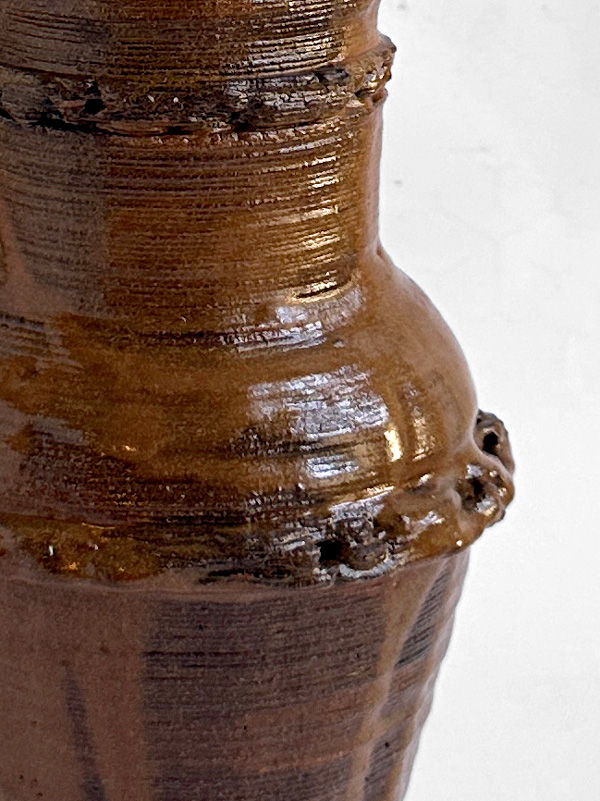
Detail.

Left, 3D model of Round Container; Right, AI-generated 3D model parts that we incorporated into our vessel design.

A pot with handles (v2), 3D-printed and hand-sculpted red clay, glaze..

A cup with handles, 3D-printed and hand-sculpted red clay with engobe wash.

Amphora, 3D-printed and hand-sculpted red clay with engobe wash.
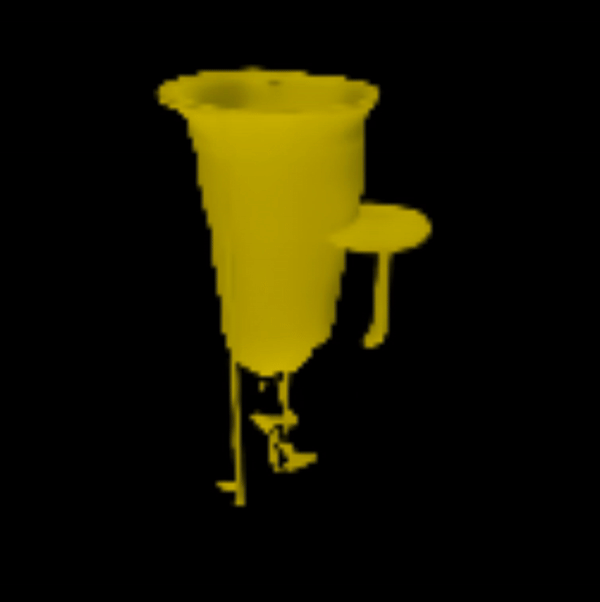
AI-generated model of “a pot” - what we consider an initial “digital sketch.”
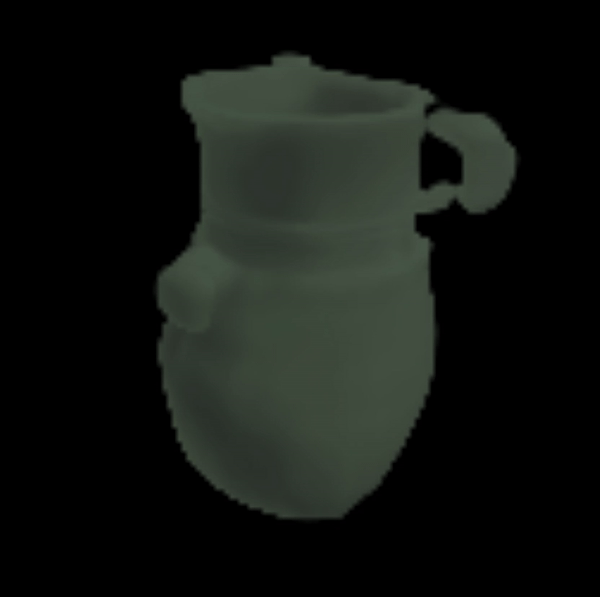
AI-generated model of “a pot”.

AI-generated model of “a pot”.

Some of our first AI-generated 3D model tests.
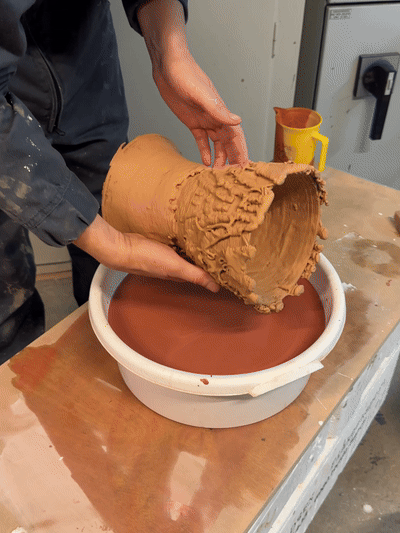 Glazing one of the models, 3D-printed in red clay.
Glazing one of the models, 3D-printed in red clay. Beaker, 3D-printed red clay, slip wash, glaze.
Beaker, 3D-printed red clay, slip wash, glaze.Clay 3D Printer
studio tool, 2019 - ongoing
My journey with clay 3D printing began unexpectedly in 2019 while building a Digital Fabrication Studio at Montserrat College of Art. Despite having no prior experience with ceramics, I fell in love with the unique qualities of clay as a material and the machine expressions that arise from the clay 3D printing process. This initial fascination led me to take a ceramics course and begin experimenting with a Potterbot clay printer to better understand the technology and its possibilities.

First clay printing experiments with a Potterbot, 2019.

First clay printing experiments with a Potterbot, 2019.

First 3 “vases” in 3D-printed porcelain, 2019.
This tool-building project took shape in 2022 when I received an Art/Tech Artist-in-Residence grant that allowed me time and support to build my own custom clay printer. I started by visiting ceramicist Anna Andersen, who works with two different types of self-built clay printers. For my printer build, I decided to combine the strengths of two existing systems: an FLSun Q5 delta printer, chosen for its stepper motors and accessible motherboard, paired with a Stoneflower 3D Ceramic printer kit that provided mechanical ram extrusion and the option for independent clay extrusion controls.
The technical development involved designing a custom mount for the printhead and modifying the firmware to accommodate the hybrid setup and custom wooden build plates. I also created custom G-code and slicing profiles using Prusa Slicer, which was already integrated with my existing 3D printing studio workflow.
The technical development involved designing a custom mount for the printhead and modifying the firmware to accommodate the hybrid setup and custom wooden build plates. I also created custom G-code and slicing profiles using Prusa Slicer, which was already integrated with my existing 3D printing studio workflow.
Researching a DIY printer build - studio visit with ceramicist Anna Andersen, Horsens, DK.
Researching a DIY printer build - studio visit with ceramicist Anna Andersen, Horsens, DK.
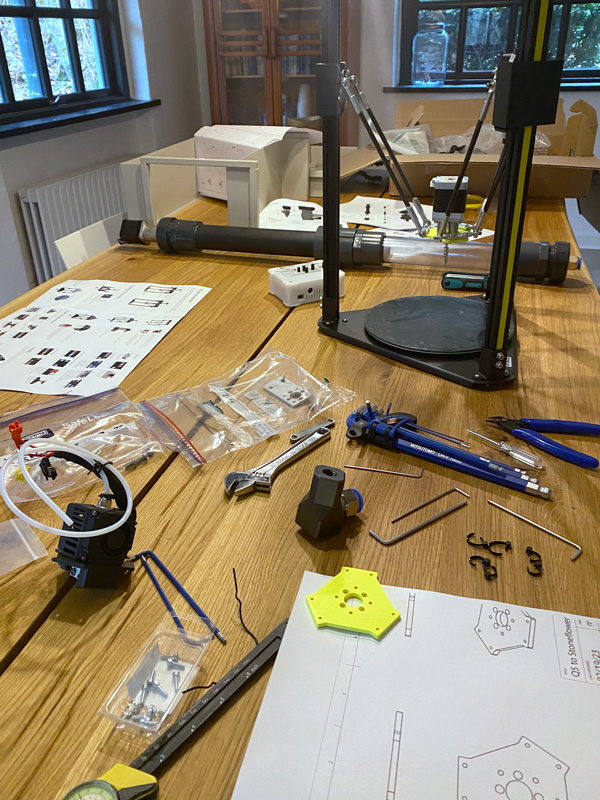
Assembling the delta printer and designing a custom printhead mount.
Dialing in custom z heights for firmware and slicer settings.
First day of operation in FabLab Spinderihallerne, Vejle, DK.

Testing printer operation and slicer settings.

It’s alive! Printing with stoneware clay.

Printer setup in studio with wall-mounted ram extruder.
After completing the build in 2023, I spent time calibrating the system and testing various types of 3D forms and clay types. The printer has since been exhibited at the Silicon Vejle festival in Vejle, DK and has become an integral tool for several of my projects, including Jord/Luft, Vibrant Soils, and Jordforbindelse. Currently, it's helping me create prototypes for my latest experimental work combining generative AI with ceramics, A pot.

Testing forms and clay bodies.

Experiments with slicer settings.
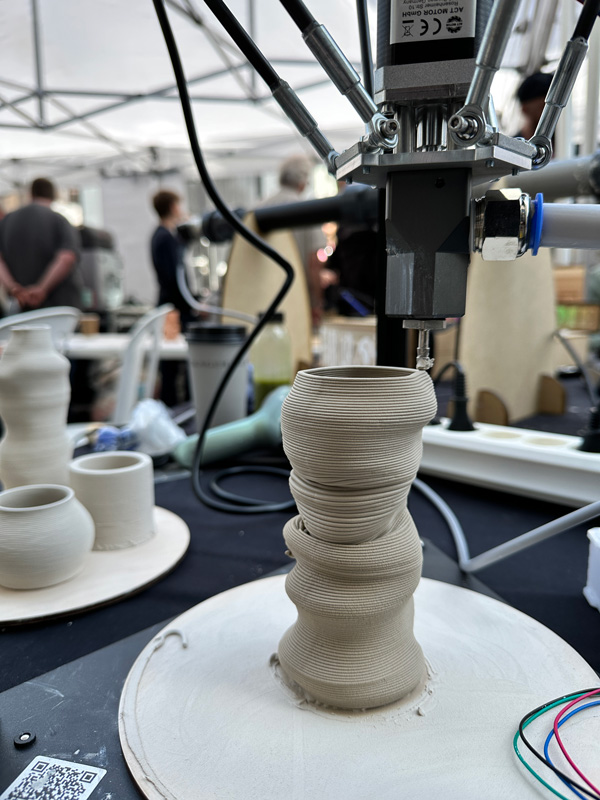
Printer on location outdoors at Silicon Vejle city festival, 2023.
Special thanks to Anna Andersen, Andrew Sliwinski and the folks at FabLab Spinderihallerne for their support and advice during the build.
Some things I found helpful:
+ Jonathan Keep’s guide to clay 3D-printing
+ Stoneflower 3D’s Ceramic 3D printer kit
+ Wikifactory Ceramic 3D printing forum
Some things I found helpful:
+ Jonathan Keep’s guide to clay 3D-printing
+ Stoneflower 3D’s Ceramic 3D printer kit
+ Wikifactory Ceramic 3D printing forum
Mirror Stage
exhibition, Vejle Kunstmuseum, 2024 - 2025
In an era where image manipulation is commonplace, the relentless pursuit of physical ideals both on screens and in real life raises some questions. What defines the perfection we seek in our physical faces and bodies? Mirror Stage attempts to blend classical ideals and new technologies in order to interrogate our societal notions of bodily perfection and our evolving connection to new technologies.
Mirror Stage is a collaborative venture between myself and artificial intelligence. At the heart of this endeavor is the use of text prompts to engage a machine learning system that generates 3D digital objects. Guided by prompts inspired by the physical ideals found in classical Western sculpture, such as 'a delicate female face' or 'the strong face of a god,' the system and I try to imagine and sculpt the quintessential human visage.
This experiment is a play between human expression and machine interpretation, existing in the uncanny valley between the digital and the tangible. The resulting forms embrace and attempt to highlight the glitches and imperfections that are always inherent in emerging technologies. Here AI is in the spotlight, as it operates using vast data sets created and aggregated by humans; the imperfections inherent in this particular technology are directly connected to our own. Mirror Stage is a challenge to reconsider our perception of the flawless and to question our evolving relationships with the machines and systems that increasingly shape our daily lives. As we humans navigate this emerging landscape, Mirror Stage aims to be a mirror reflecting not only our ideals but also the complexities of our existence in an age of relentless technological innovation.
This project is shown as a part of the group exhibition Kropumulig Kroputrolig at the Vejle Kunstmuseum in Vejle, DK. The exhibition was curated by Trine Grøne and features artists Mia Mai Dengsø Graabæk, Soren Thilo Funder and Lærke Posselt. Exhibition images courtesy of Kenneth Stjernegaard and Vejle Kunstmuseum. Funding for realizing this work courtesy of Statens Kunstfond and Vejle Kunstmuseum.
+ Vejle Museums’ Exhibition Page
+ Press Release
Mirror Stage is a collaborative venture between myself and artificial intelligence. At the heart of this endeavor is the use of text prompts to engage a machine learning system that generates 3D digital objects. Guided by prompts inspired by the physical ideals found in classical Western sculpture, such as 'a delicate female face' or 'the strong face of a god,' the system and I try to imagine and sculpt the quintessential human visage.
This experiment is a play between human expression and machine interpretation, existing in the uncanny valley between the digital and the tangible. The resulting forms embrace and attempt to highlight the glitches and imperfections that are always inherent in emerging technologies. Here AI is in the spotlight, as it operates using vast data sets created and aggregated by humans; the imperfections inherent in this particular technology are directly connected to our own. Mirror Stage is a challenge to reconsider our perception of the flawless and to question our evolving relationships with the machines and systems that increasingly shape our daily lives. As we humans navigate this emerging landscape, Mirror Stage aims to be a mirror reflecting not only our ideals but also the complexities of our existence in an age of relentless technological innovation.
This project is shown as a part of the group exhibition Kropumulig Kroputrolig at the Vejle Kunstmuseum in Vejle, DK. The exhibition was curated by Trine Grøne and features artists Mia Mai Dengsø Graabæk, Soren Thilo Funder and Lærke Posselt. Exhibition images courtesy of Kenneth Stjernegaard and Vejle Kunstmuseum. Funding for realizing this work courtesy of Statens Kunstfond and Vejle Kunstmuseum.
+ Vejle Museums’ Exhibition Page
+ Press Release


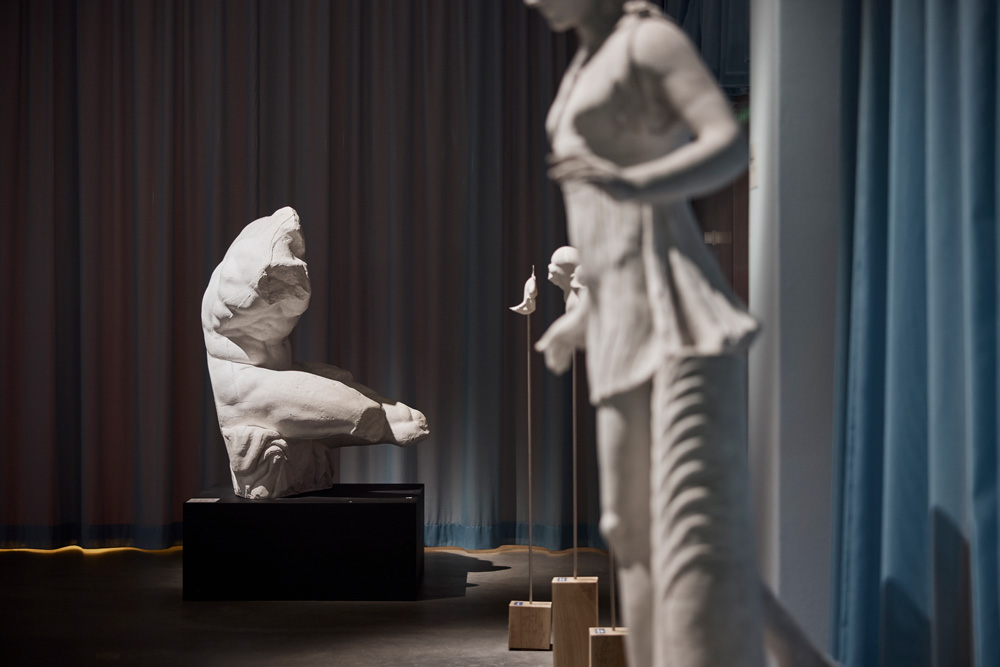
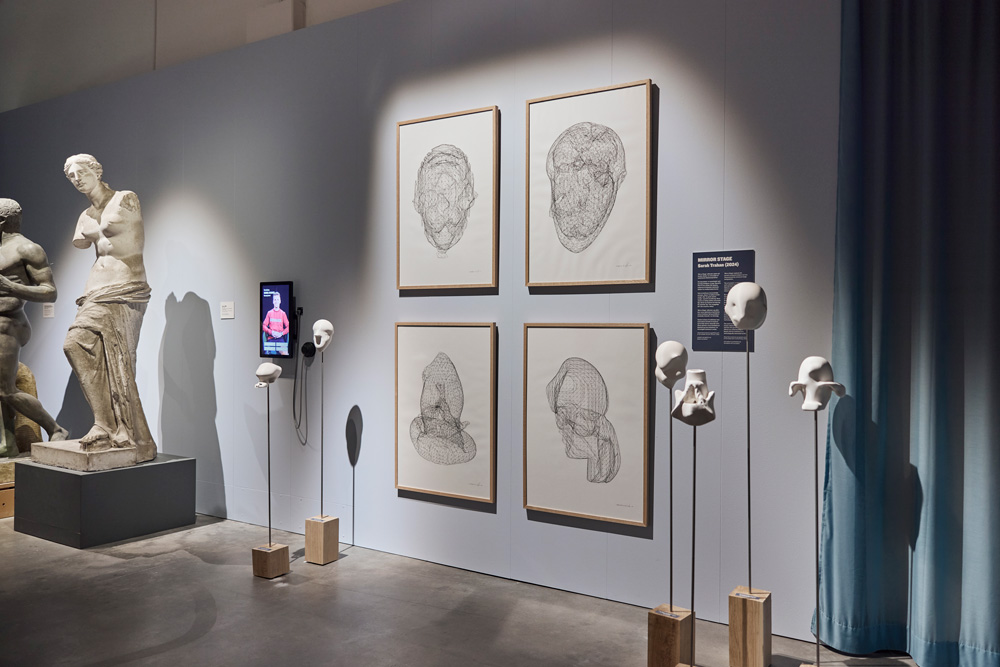
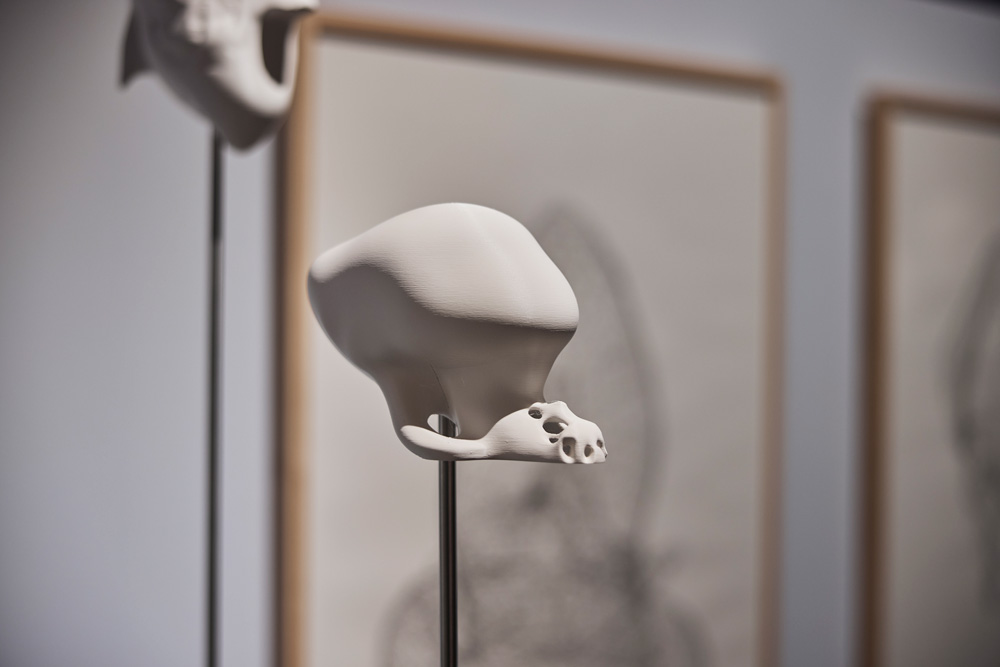
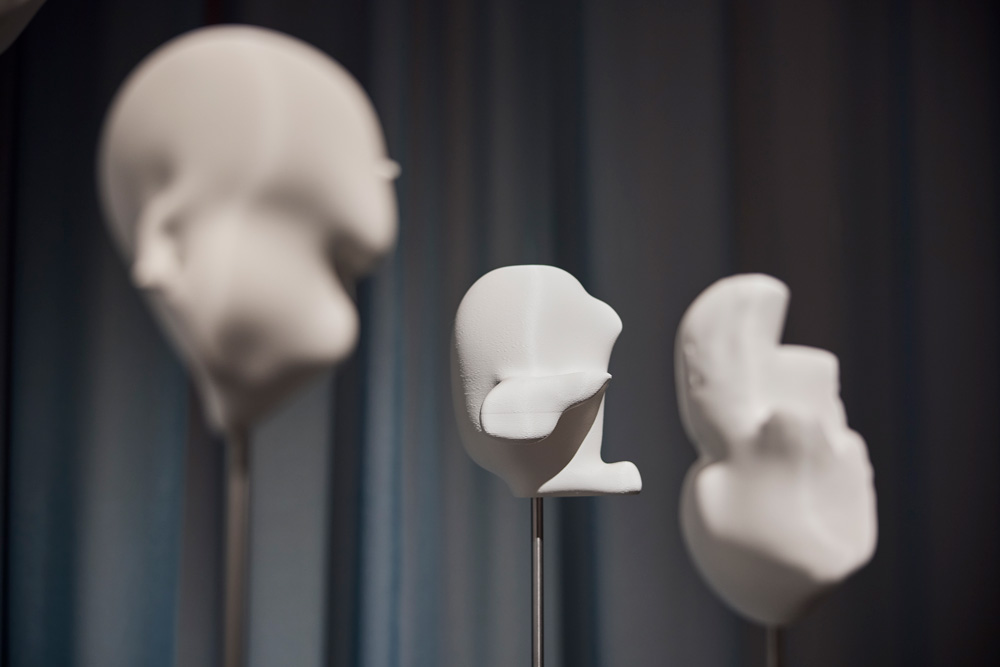
 A head with flowing hair, archival inkjet print of AI-generated mesh, 70 x 100 cm.
A head with flowing hair, archival inkjet print of AI-generated mesh, 70 x 100 cm.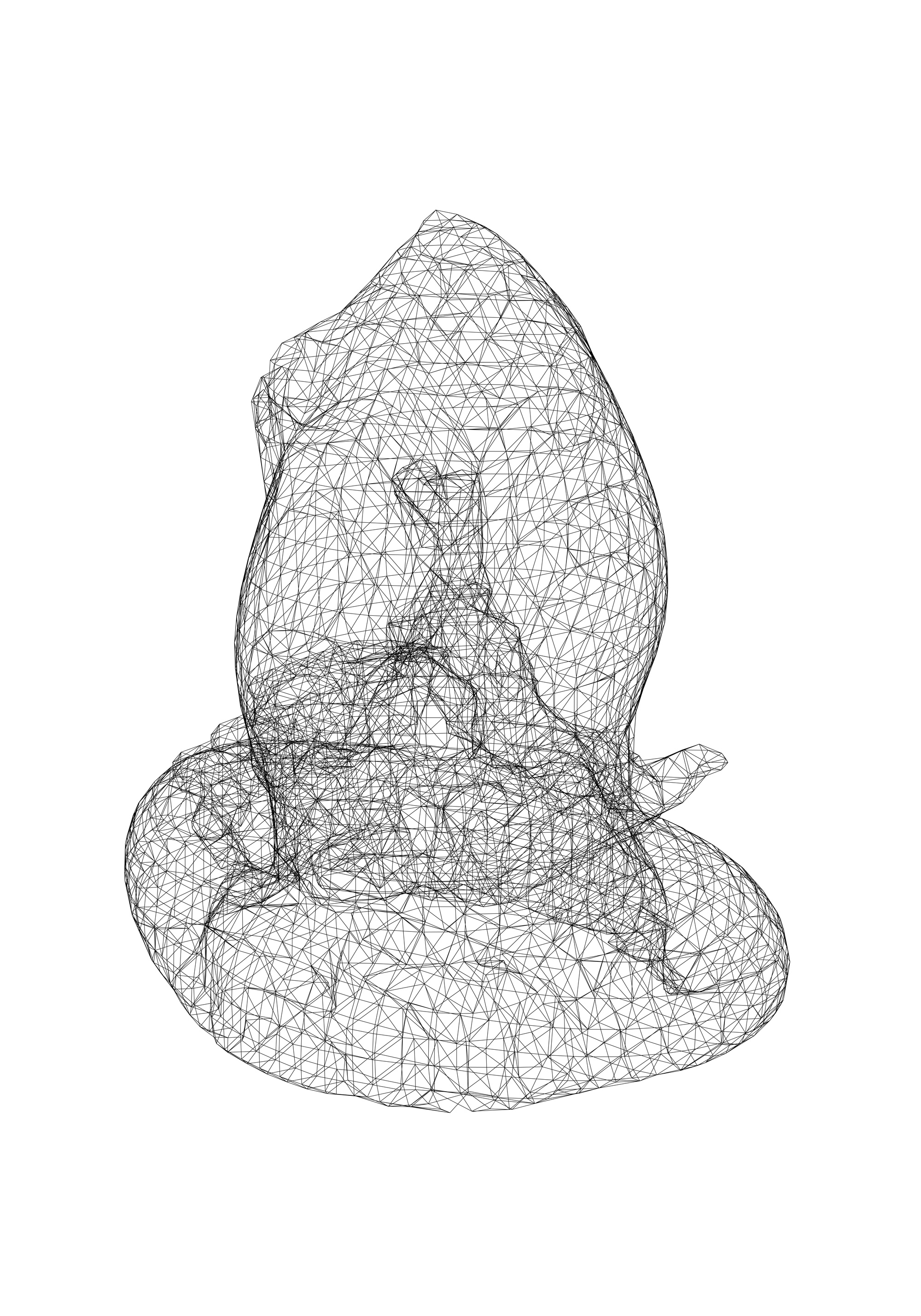
A delicate female face, archival inkjet print of AI-generated mesh, 70 x 100 cm.

A beautiful visage, archival inkjet print of AI-generated mesh, 70 x 100 cm.
 A perfect human face, 3D-printed plaster/bioplastic, 16 x 16 x 19 cm.
A perfect human face, 3D-printed plaster/bioplastic, 16 x 16 x 19 cm. Detail.
Detail.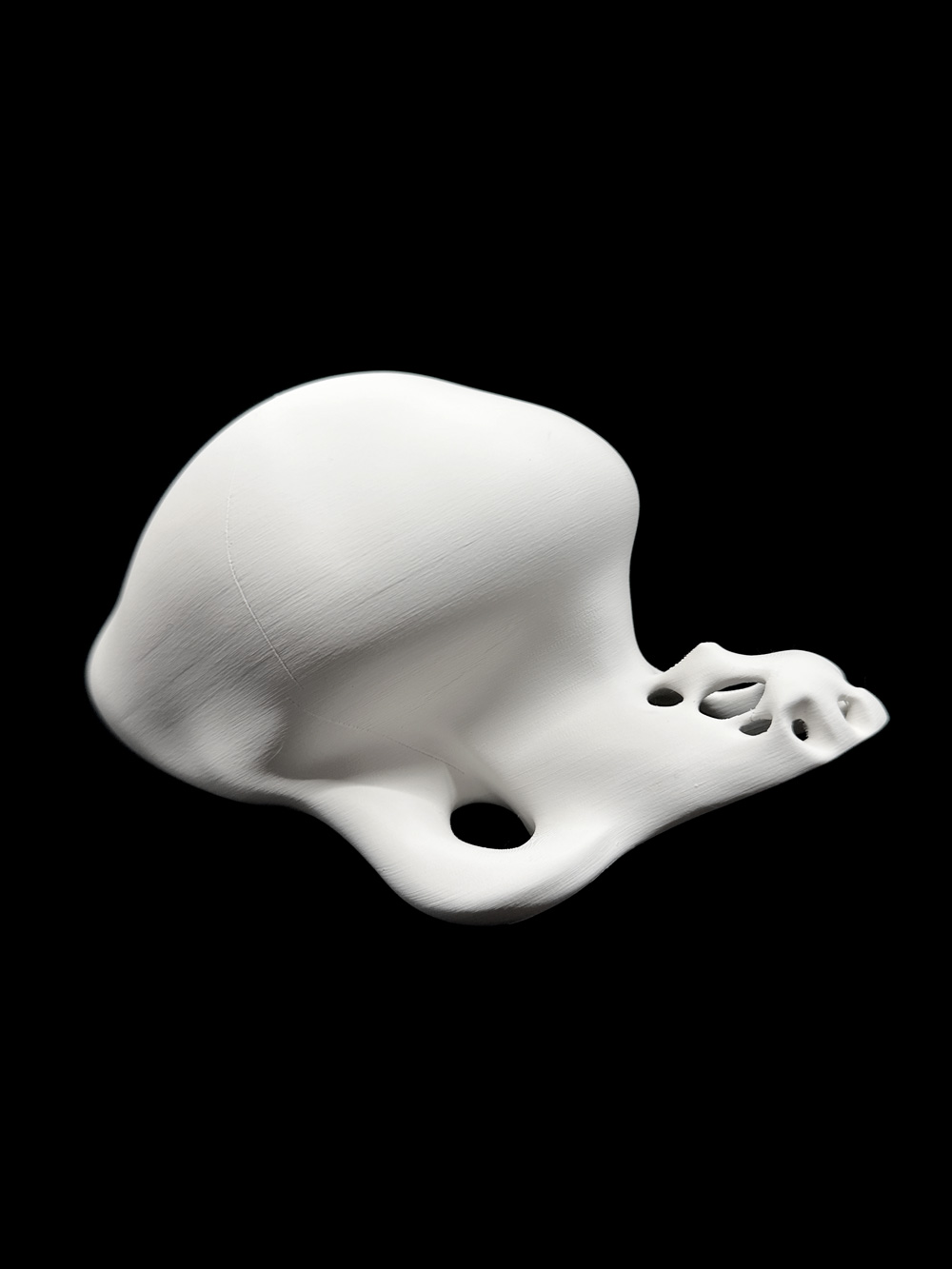
An ideal face, 3D-printed plaster/bioplastic, 19 x 13 x 16 cm.
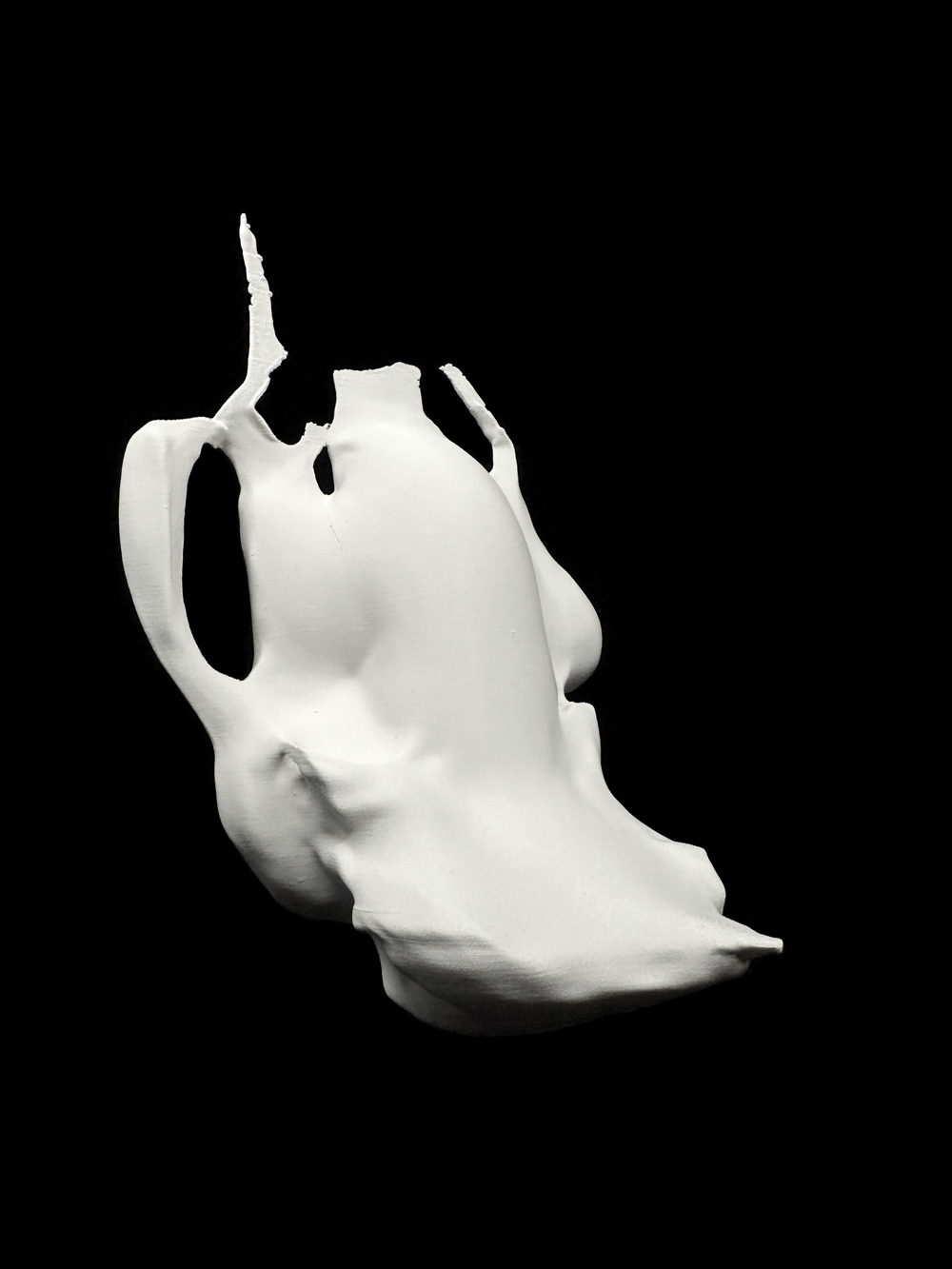
The face of a god, 3D-printed plaster/bioplastic, 12 x 10 x 15 cm.
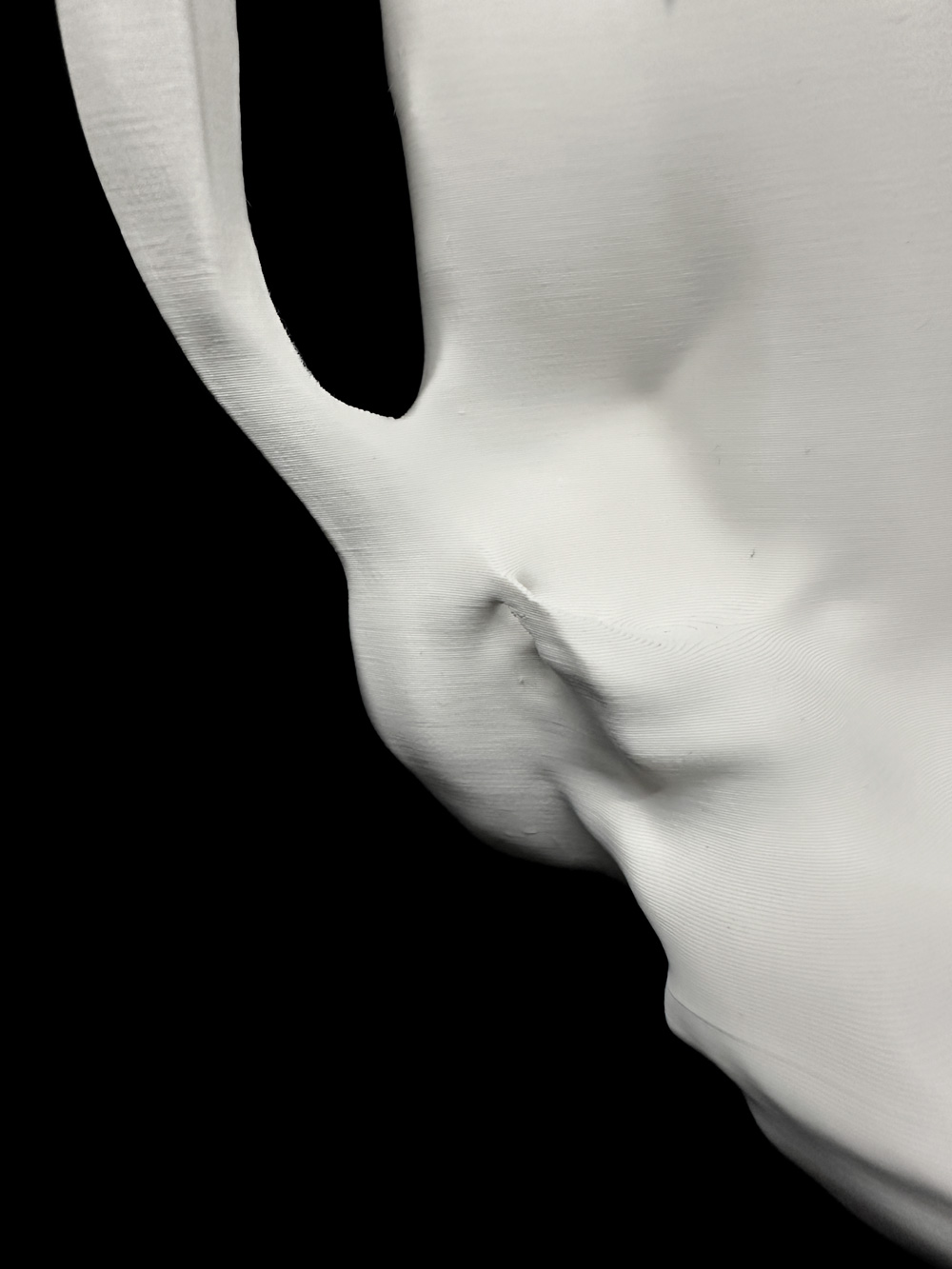 Detail.
Detail.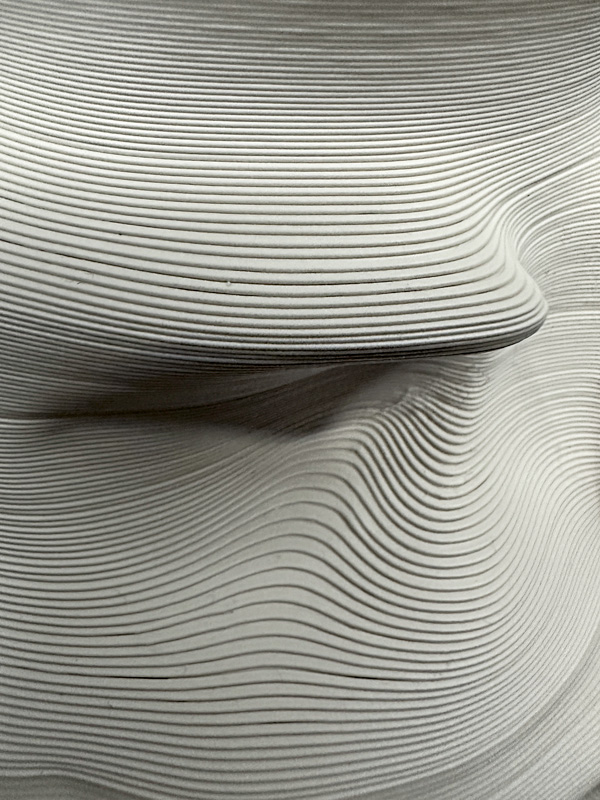 Surface detail.
Surface detail.Art/tech Artist-in-Residence, Vejle Kommune
residency and exhibition, 2022 - 2023
From 2022 to 2023, I served as the Art/tech artist-in-residence for Vejle municipality, Denmark; a role that combined art education with personal creative practice. The AIR role had two main parts: working with teachers, students, and decision-makers to create workshops and events that taught people about new technology through art and play, and developing my own art and technology projects. This dual focus allowed me to explore how artistic practice can serve both educational and creative research purposes.
The residency fostered collaborations with educators, researchers, students, and artists from Denmark and beyond, each bringing different perspectives to questions about art, technology, and learning. These 16 months of work culminated in Sarah Trahan: Art/tech Huskunstner, an exhibition at Spinderihallerne that documented and displayed the various projects and partnerships that emerged during my time as AIR. The exhibition was organized around four areas — Teacher Collaboration & Workshops, Art in the FabLab, BioTechLab Experiments, and Fermenting Data — and included objects, photographs, and documentation from my own art/tech projects and experiments including my self-built clay printer, With/in a Landscape, Vibrant Soils, Hot Plastic, and Surface Error.
This residency was made possible through support from Vejle kommune and a generous grant from Statens Kunstfond. Other supporting partners for the residency include Vejle Bibliotekerne, Vejle Musik-og kulturskole, FabLab Spinderihallerne, BioTechLab Spinderihallerne and the Fermenting Data project. Images and video courtesy of Jonas Normann.
+ Interview in Kulturmonitor
+ Spinderihallerne AIR page
+ #arttechhuskunstner on Instagram
The residency fostered collaborations with educators, researchers, students, and artists from Denmark and beyond, each bringing different perspectives to questions about art, technology, and learning. These 16 months of work culminated in Sarah Trahan: Art/tech Huskunstner, an exhibition at Spinderihallerne that documented and displayed the various projects and partnerships that emerged during my time as AIR. The exhibition was organized around four areas — Teacher Collaboration & Workshops, Art in the FabLab, BioTechLab Experiments, and Fermenting Data — and included objects, photographs, and documentation from my own art/tech projects and experiments including my self-built clay printer, With/in a Landscape, Vibrant Soils, Hot Plastic, and Surface Error.
This residency was made possible through support from Vejle kommune and a generous grant from Statens Kunstfond. Other supporting partners for the residency include Vejle Bibliotekerne, Vejle Musik-og kulturskole, FabLab Spinderihallerne, BioTechLab Spinderihallerne and the Fermenting Data project. Images and video courtesy of Jonas Normann.
+ Interview in Kulturmonitor
+ Spinderihallerne AIR page
+ #arttechhuskunstner on Instagram
Image from Intro to Clay 3D Printing AIR workshop.
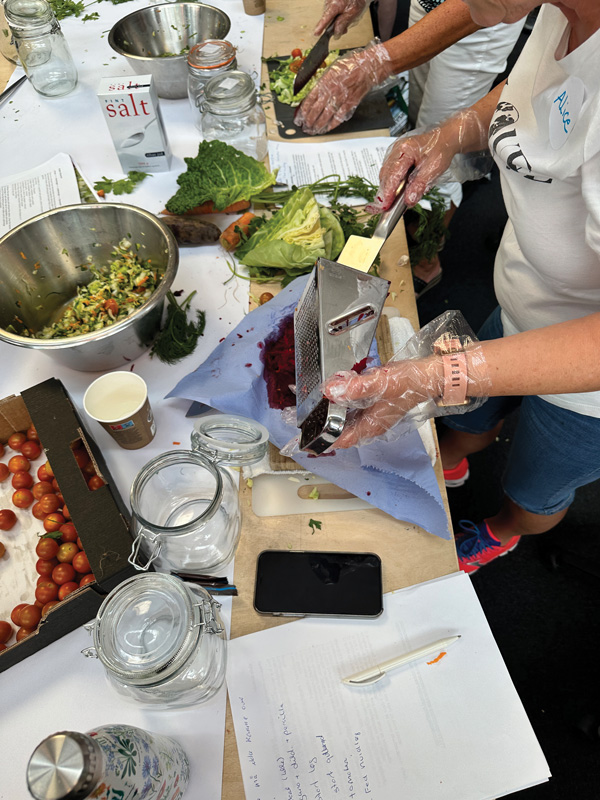
Image from Fermenting Data AIR workshop series.
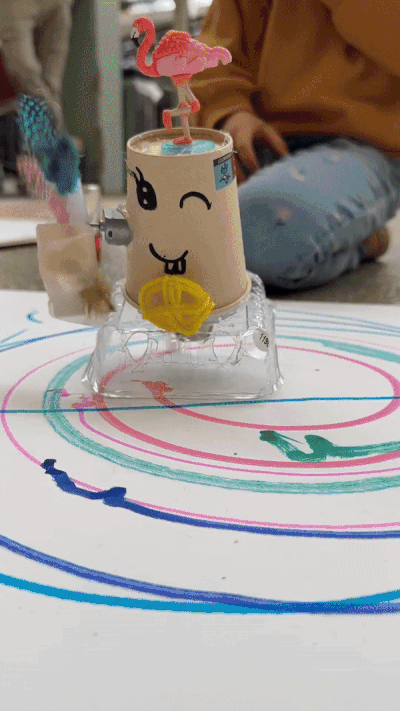
Images from ArtBot! AIR workshops with teachers, students and parents.

Image from AIR Playing in 3D workshop, FabLearn Conference.

Exhibition view, Art in the FabLab.
 Detail.
Detail.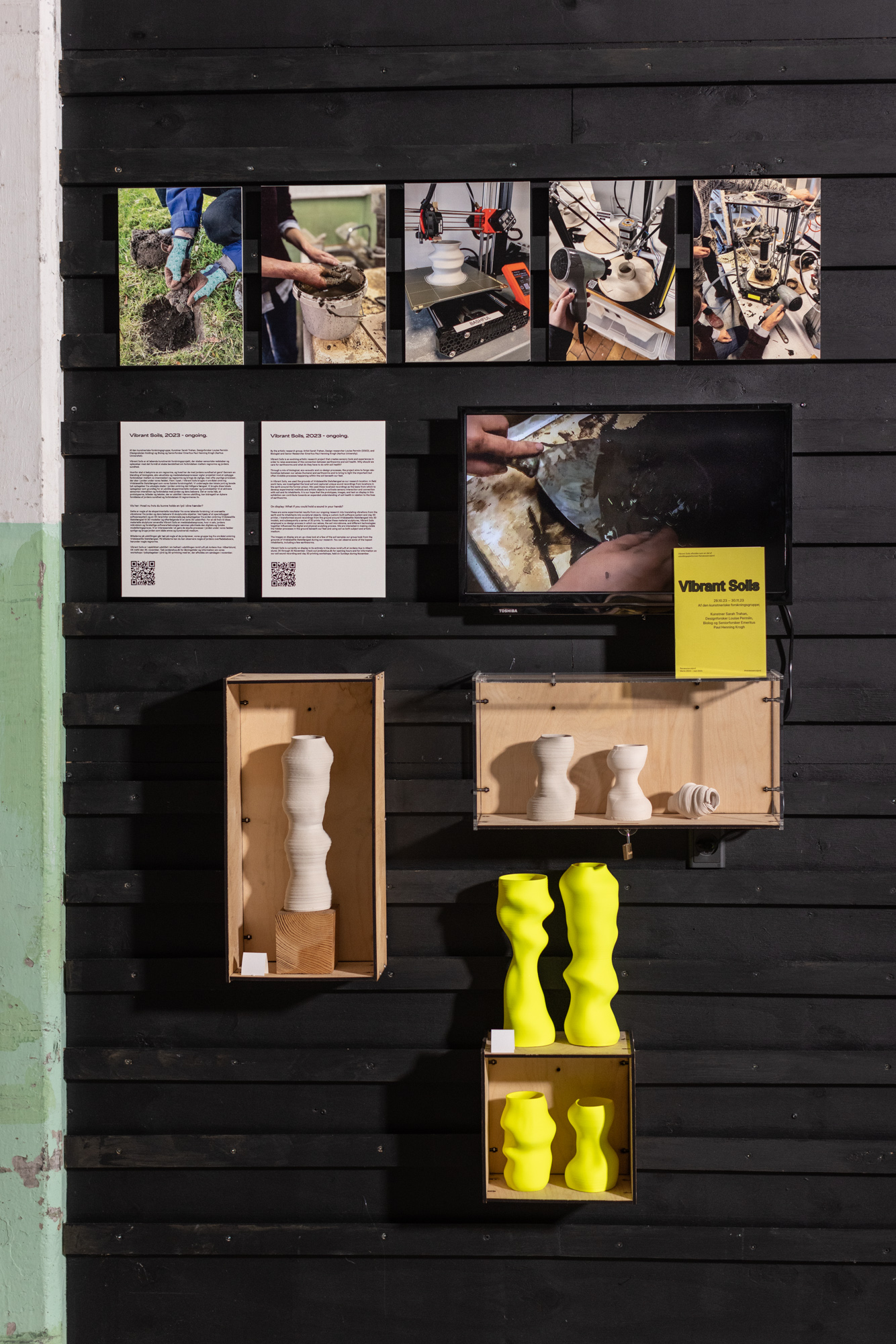
Exhibition view, Vibrant Soils project.

Exhibition view, Vibrant Soils project.
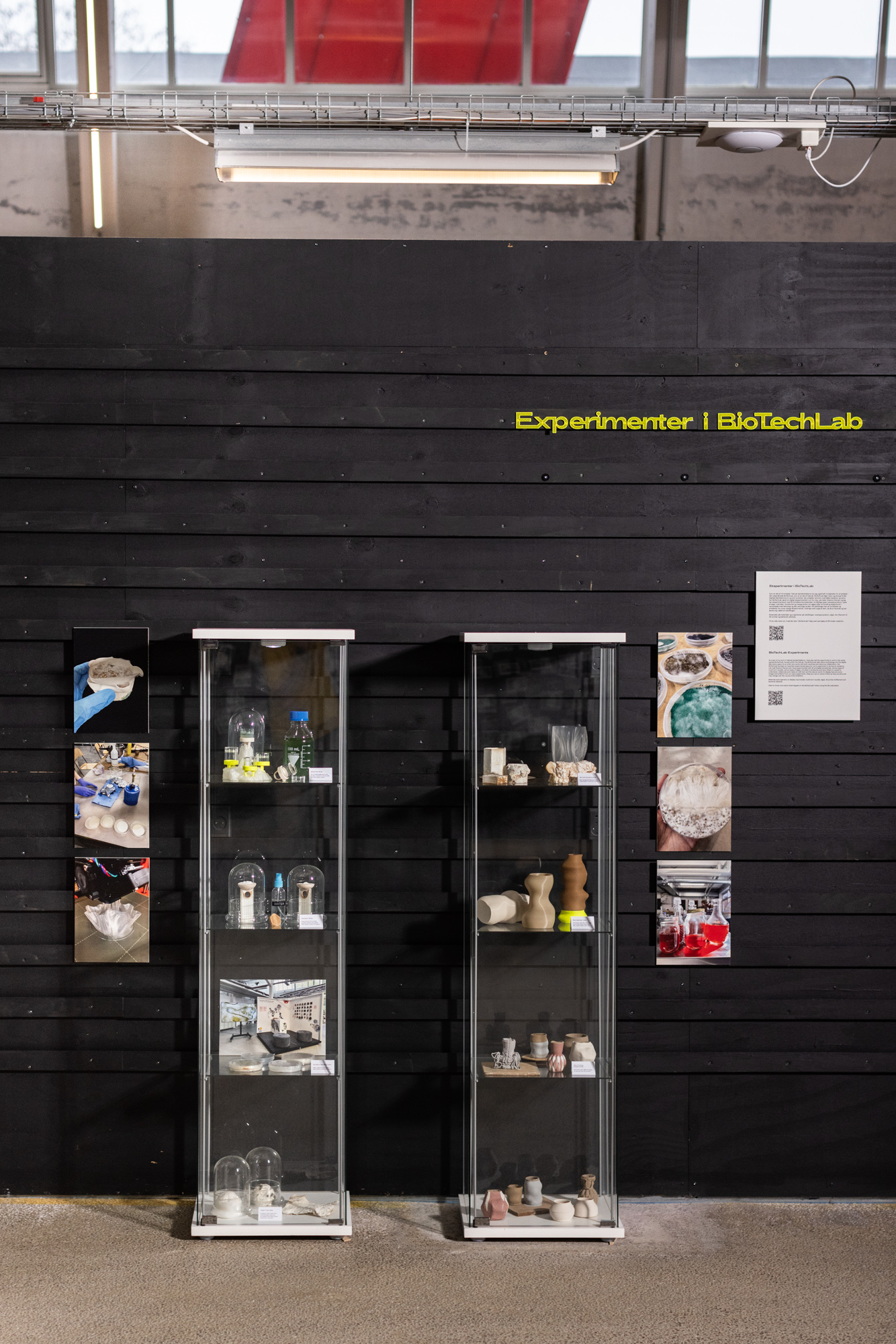
Exhibition view, BioTechLab Experiments.
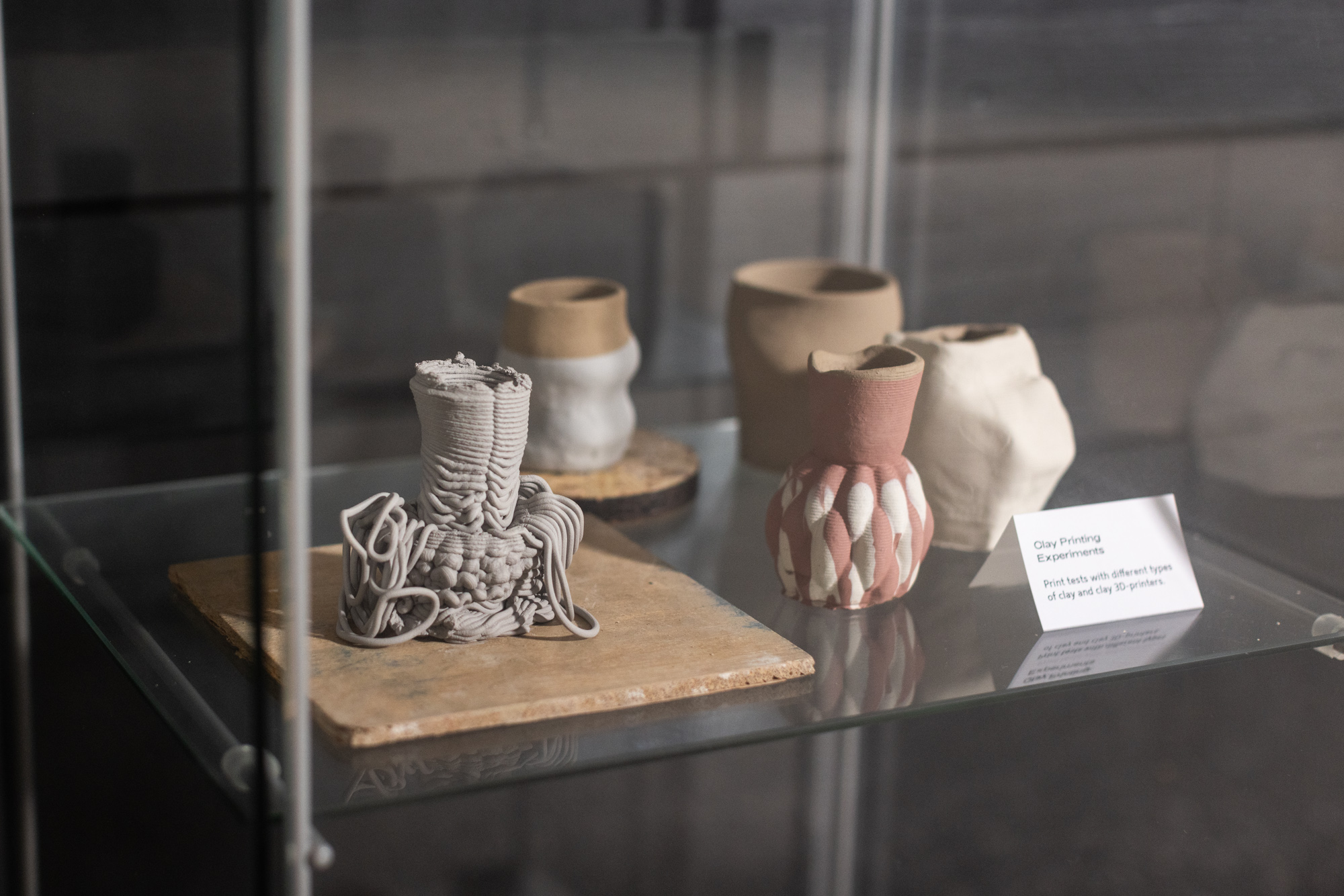
Detail, clay prints.
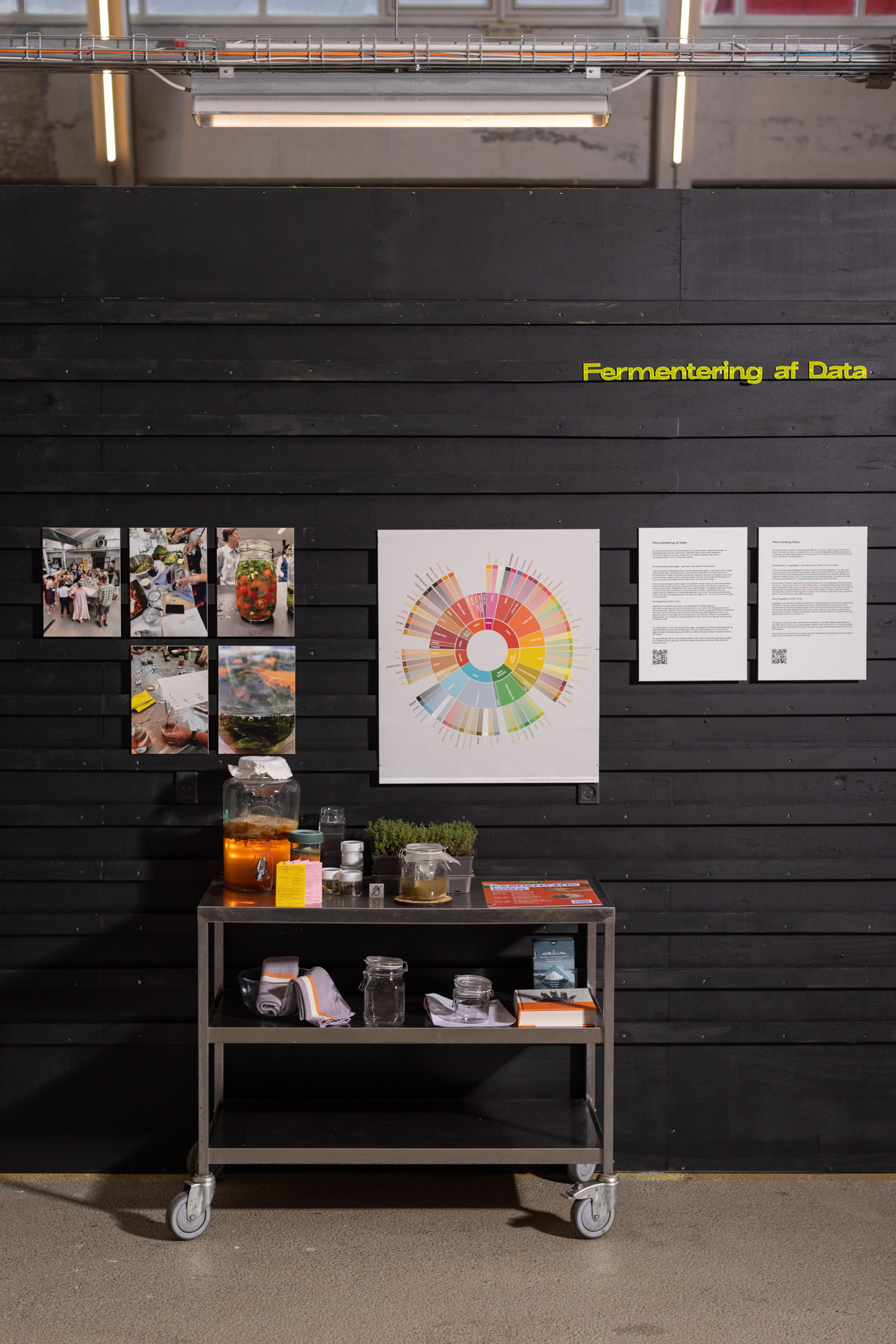
Exhibition view, Fermenting Data.
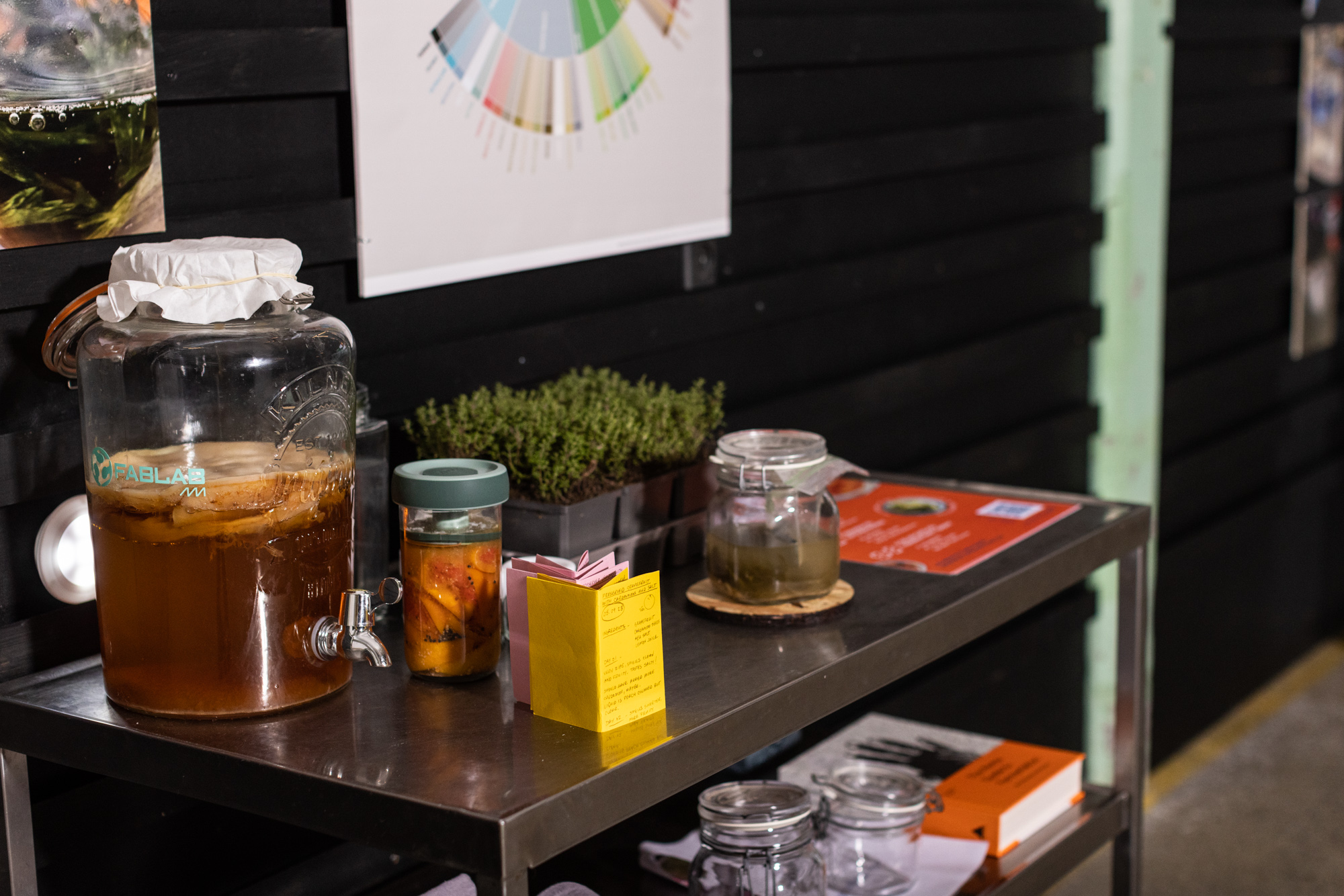
Detail, artifacts and ferments from workshops.